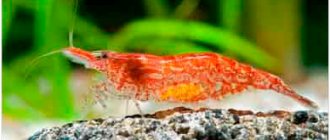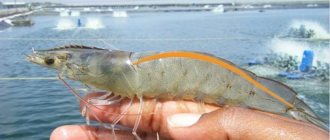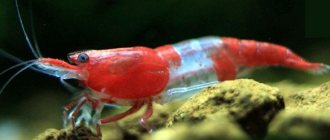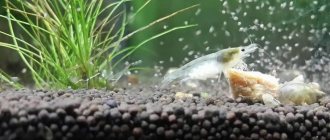More and more aquarists have recently wanted to keep shrimp: they are interesting to watch, they are unpretentious, and the abundance of colors can be the envy of any fish. The three anterior thoracic segments of shrimp are fused with the head and are securely covered with a protective shell. Characteristic features of the appearance of shrimp are mustaches, jaws and jaws. Thanks to their abdominal legs (pleopods), shrimp swim, and with their help they snatch small pieces of dry food and aquatic plants from the water. On walking legs, shrimp move along the bottom, looking for leftover food. In fact, shrimp only seem clumsy: they quickly get used to the aquarium, it is quite difficult to catch them, but it is very interesting to watch their school life.
photo: Aquarium with shrimps
Appearance and natural habitat
The giant shrimp (also known as the Rosenberg shrimp) is one of the most popular and widespread members of the crustacean family. In nature, it lives in the reservoirs of India, Australia, Vietnam, New Guinea and Malaysia, but recently it has been grown in almost all corners of the planet.
The name of the giant shrimp is quite justified, since the size of an adult specimen is about 32 cm or even more, and the weight category , on average, reaches about 250 g. Therefore, to keep such a mollusk at home, you will need a fairly large and spacious artificial reservoir.
A characteristic feature of the giant shrimp is its long claws of a rich black color, and in most cases one of the limbs is noticeably shorter than the other. It is also noteworthy that only males have claws; females do not have them.
The claws of the giant shrimp perform numerous useful functions:
- food production;
- orientation in the water space, the ability to sense the approach of a predator or changes in the parameters of the aquatic environment;
- a means of fighting opponents and relatives when fighting for territory, the attention of the female, defending leadership positions;
- a tool for capturing and holding the female during mating.
Another peculiar feature of the appearance of the Rosenberg shrimp is its amazing mustache of a bright orange color, the length of which is several times greater than the size of the entire body of the mollusk. Also on the head of this crustacean there is a noticeable nose of a rich scarlet shade that attracts everyone’s attention.
The color of the giant shrimp can vary. Most often in nature there are representatives that have a brownish or blue color in males and a silver-gray color in females. Much less often one comes across colorless and almost transparent specimens, which, however, as they grow older acquire weakly expressed camouflage shades.
In addition, some scientists claim that the color of the giant shrimp may change depending on the color of the soil and its living conditions, but this hypothesis has not yet received reliable confirmation.
Description
Japanese macrobrachiums in their homeland inhabit mainly rivers and streams with clean water. The length of these shrimp does not exceed 7-8 cm. They owe their generic name, which can be translated from Latin into Russian as “big-armed”, to the relatively large, in comparison with the size of the body, claws on the first pair of jaws. Distinctive features of the Japanese river shrimp are a transverse black streak on the back, decorated with a white border, white socks on walking legs and orangish claws; in dominant males they become brick-red. The body of the shrimp is translucent and brownish. The older the individual, the more richly colored it is.
Peculiarities of behavior in the natural environment and lifestyle of the giant shrimp
By their nature, giant shrimp are predatory creatures, although they do not disdain plant foods, but their hunting instincts are quite clearly expressed in them. These representatives of the crustacean family are predominantly nocturnal, preferring to sleep during the day in a secluded, shaded place, and at dusk they go hunting and search for food.
The Rosenberg shrimp is a mollusk that prefers to lead a solitary lifestyle and is always on guard, defending its territory from uninvited guests and outsiders. Moreover, unlike most other crustaceans, a representative of the stronger sex will fight for territory not only with the male, but even with the female, except during the mating period for the purpose of reproducing offspring.
But this only applies to a collision between 2 males. In their natural habitat, giant shrimp form peculiar families in which one male and several females live. With this way of life, the mollusks coexist peacefully, take care of their offspring, and the male also protects not only the territorial space, but also his small “harem” from potential danger.
Giant shrimp are very neat creatures. These clams endlessly clean themselves, removing bits of dirt and dust. However, this habit is determined not so much by a love of cleanliness, but by the fact that various kinds of pollution can negatively affect the sensitivity indicators of the Rosenberg shrimp, which it needs both for hunting and searching for food, and for orientation in space, protection from potential enemies.
Using shrimp in cooking
What do you cook with shrimp? Why aren't they cooking? Food with these seafood becomes very tasty!
Most often, perhaps, they are used as an independent dish or the basis of a nutritious dinner, lunch and even breakfast. To do this, crustaceans can be boiled, baked, fried with vegetables or sauces, herbs and spices.
They are also often used in soups, appetizers, salads, and added to pasta or risotto.
The most interesting recipes with shrimp are usually found in the cuisines of countries on the coasts of which seafood is caught. For example, in Asian countries and island countries, shrimp are added to fried noodles and various Korean and Japanese spicy dishes.
The variety of culinary possibilities that opens up to those who have shrimp in their refrigerator is unlimited.
Keeping at home
Keeping a giant shrimp at home is not very easy, but if you have the desire, it is quite possible. Aquarists note that these crustaceans not only look beautiful, decorating the aquarium, but also display extremely funny habits, which can be observed with great interest.
In order for the Rosenberg shrimp to live a long time, maintain its activity and feel comfortable, the aquarist will have to try and create in advance all the necessary conditions for it, which, according to the recommendations of experts, should be as close as possible to its natural habitat.
Requirements for an aquarium
An aquarium for keeping giant shrimp must be very large and spacious. The best option would be a concrete or plastic pool with a large bottom area. The height of the walls and the volume of the tank are not so important, but nevertheless the shrimp should have a sufficient amount of free space for comfortable life and privacy.
Overpopulation of an artificial reservoir and crowded conditions can lead to frequent conflict situations, outbreaks of aggression and fights between relatives, often ending in serious traumatic injuries and even death of giant shrimp.
Since these crustaceans are quite mobile and active, they tend to get out of the tank. However, without an aquatic environment, giant shrimp can live for only a short time.
Therefore, experienced aquarists strongly recommend taking care of the safety of their pets by covering the artificial pond with transparent protective glass to avoid adverse consequences.
The aquarium will need to be equipped with an additional heater (giant shrimp are accustomed exclusively to tropical climates) and a filter. It is also necessary to ensure that the current in the artificial reservoir is not too strong. As for lighting, the Rosenberg shrimp prefers soft and dim lighting. The optimal duration of daylight hours is from 10 to 12 hours throughout the day.
The ideal soil for this representative of crustaceans will be dark river sand. It is desirable that there are depressions and terraces in the soil, allowing one to recreate conditions close to natural.
Parameters of the aquatic environment
The giant shrimp is extremely sensitive to its environment and its parameters, and has difficulty with changing climatic conditions. Therefore, aquarists need to carefully monitor the maintenance of water levels in the tank:
- temperature – from +24° to +28°С;
- hardness – from 5° to 10°;
- acidity – from 6.5 to 8.5.
Particular attention should be paid to monitoring temperature indicators. When the water temperature drops to +20° C, the shrimp first stop feeding, become lethargic and lose the ability to reproduce, and when it reaches +13° and below, they die. Experts advise purchasing a heating device with automatic control and regulation, ensuring that the optimal temperature is maintained.
In addition, Rosenberg shrimp needs increased oxygen levels. But it reacts extremely negatively to nitrites and nitrates. As their indicators increase, the color, behavior, and size of the mollusk change. To determine the level of the above elements in the aquatic environment, there are special tests that can be purchased at most pet stores.
Decorating the aquarium
When designing an artificial reservoir intended for keeping and growing Rosenberg shrimp, it is necessary to ensure that there is a sufficient number of shelters and reliable shelters in the reservoir. For these purposes, both ordinary stones, driftwood, thickets of algae and greenery, as well as ceramic castles, caves and grottoes are perfect.
Such secluded places are vital for the giant shrimp. The fact is that this mollusk molts quite often, exchanging its old shell for a new one. During this period, the shrimp becomes especially vulnerable and defenseless, not only for predators, but even for its relatives, since cannibalism among crustaceans is a very common phenomenon.
As for decorating the aquarium with green spaces, it should be taken into account that giant shrimp love to feast on the leaf blades of aquatic and surface crops, which results in damage and death of plants. Therefore, the best option would be crops such as ophiopogon (snakebeard) or cryptocoryne - plants that are inedible for shrimp.
You can also divert the attention of crustaceans from green spaces by periodically feeding them with leaf blades of burdock, dandelion, lettuce, spinach, and nettle. Small pieces of fresh vegetables or fruits will also work. The shrimp will like this kind of food, and they will prefer it to the greenery growing in the aquarium. However, if these tricks do not help, then it is worth removing plant crops from the aquarium, replacing them with artificial plants that perform both decorative and protective functions.
The results of scientific research and testing have proven that Rosenberg shrimp, although with difficulty, can still adapt to other parameters of the aquatic environment and living conditions, but at the same time their life expectancy is significantly reduced.
If you follow the recommendations listed above, a giant shrimp can live in an artificial environment for up to 5 years or even longer.
How can shrimp be dangerous?
It is important to understand that wild-caught shrimp and farmed shrimp differ significantly in more than just size. They have a radically different composition of meat, which depends on the nutrition of the individuals during cultivation. No one is recommended to eat raw or cooked shrimp that have grown in environmentally unfavorable waters. They have an extremely high allergic potential. Many producers raise crustaceans using antibiotics, superphosphate, caustic soda and many other chemicals that accumulate in shrimp meat and end up in dishes that are actually supposed to be healthy. In fact, this is real harm to the body.
It is important to check the conditions for catching shrimp so as not to harm the body.
Shrimp meat immediately after catching can be treated with pyrophosphates to avoid moisture loss. Such manipulation should always have a certificate - only if done correctly, it does not affect the quality of the product. If the processing was carried out by non-professionals, using low-quality chemicals, the meat may either become too soft and soapy or rubbery and tough. Often in this case a metallic taste appears.
- It is important to completely remove shrimp from the diet if episodes of food allergies were noted on the days of their consumption, or manifestations of intolerance were identified. If the body does not tolerate seafood well, you should exclude it from the diet for 3-4 months, and then, if desired, carefully introduce it into the menu, gradually and without excessiveness.
- If you know you are allergic to tropomyosin in shrimp, eating shrimp may cause nasal congestion and skin rashes.
- For people diagnosed with atherosclerosis in the acute phase, it is important to understand that shrimp contain quite high cholesterol - about 200 mg per 100 grams of product.
Shrimp are stored fresh and cooked for only a short time - it is important to correctly determine the degree of their freshness. If there is the slightest sign of a poor-quality product, spoilage of dishes with shrimp - the appearance of a pronounced smell of fish or shellfish, the presence of a damaged shell or black spots on the surface - you should refuse to eat it.
Features of feeding
The Rosenberg shrimp is an omnivore, so there are usually no problems feeding it at home. Crustaceans happily consume both natural and frozen or dry food. It is recommended to periodically feed mollusks with tubifex, daphnia, etc. After all, as predators, giant shrimp need live, high-protein food.
Rosenberg shrimp will certainly enjoy chopped fruits and vegetables, herbs pre-processed in boiling water, as well as leaf blades of various plants.
To maintain an optimally balanced diet, a combination of animal and plant foods is recommended, but a large percentage of the menu should consist of live food.
In addition, in pet stores you can purchase ready-made food intended specifically for feeding crustaceans. It is recommended to feed the shrimp once every 1-2 days, trying to calculate the amount of food so that it is immediately eaten and does not have time to settle to the bottom, since otherwise you will have to clean the soil and siphon the soil (read more about how to properly siphon the soil in an aquarium) .
Nutrition
Shrimp feed on a variety of food: dying aquatic plants and other organic debris, aquatic insects, polychaetes, tubifex, bloodworms, daphnia, and coretra. They also eat plants, preferring soft-leaved ones (such as ceratopteris). They eagerly eat dead fish, snails and other animals, and do not refuse dry food. Shrimp are omnivores, so dry food Sera vipan and Sera microgran are good for them. Brightly colored species with a predominance of red pigment should be fed Sera san and Sera flora. For variety, in addition to flake food, shrimp can be fed Sera plankton tabs and Spirulina tabs.
Reproduction in artificial environment
Reproduction of giant shrimp in aquarium conditions is quite possible, but will require some time and effort. To get healthy offspring, you need to go through 3 stages:
- Preparatory . At this time, several females are placed in a separate tank with a temperature of about +22°C and kept there for 3 weeks. All this time, it is recommended to feed the females generously with high-quality, live, fortified food.
- Reproduction . After 3-4 weeks of preparation, one male is placed in a container with several females. In most cases, caviar is formed after a few days. After this, the father is sent back, and the females take care of the eggs, independently separating live eggs from dead ones.
- Larval stage . The larvae begin to be fed on the 2nd day from the moment of their birth, using artemia for this purpose. Upon reaching a week of age, the diet includes minced fish and chopped egg yolk. In general, the process of formation of a shrimp from a larva involves the passage of 12 stages. It is recommended to keep young shrimp in a separate tank to avoid cannibalism. It is best to place them in a community aquarium when they reach sexual maturity - at the age of about 3-4 months.
The giant shrimp is an interesting and unusual aquarium inhabitant. Although its maintenance requires some effort, most experienced aquarists cope well with this task and are very proud of their original pets with exotic appearance and peculiar habits.
Benefits of shrimp
The great benefits of shrimp for men, women and children lie in their whitish, protein-rich meat. At the same time, if you cook shrimp correctly, then the crispy chitinous shell that is part of the animal’s structure can become a useful addition to the diet. It is chitin that can become an analogue of plant fiber, which is not digested in the stomach.
However, all discussions about the benefits of shrimp should begin from the moment of choosing a suitable product. Only those shrimps that have grown in wild waters or on farms with an organic approach to the cultivation of crustaceans can be called definitely useful.
A valuable protein with excellent bioavailability, shrimp is ideal for those who are limiting their consumption of red meat, following a Mediterranean diet, following a flexitarian approach to their diet, trying different ways to lose weight, or simply want to eat a more varied, healthy and delicious diet.
Here are a few more reasons to at least occasionally include shrimp dishes in your menu:
- These seafood sufficiently contain folic acid, which is in short supply in almost all inhabitants of the planet. It is especially important to adjust the level of folate in the body for women of fertile age. Since any beneficial substances are much more efficiently absorbed by the human body when taken with food, it makes sense not to limit yourself to pills during pregnancy planning and gestation, but to additionally eat foods with folic acid.
- It is important to include shrimp in the diet from the age of 40 - this is a powerful prevention of cardiovascular diseases.
- This product is indispensable for normalizing weight. It will be delicious and completely low-calorie!
- For libido function, shrimp is one of the recommended foods. Enjoy life to the fullest by simply eating wisely.
- Note to athletes: eating shrimp regularly is important if you are building muscle tissue structure. The proteins present in crustaceans are ideal for the development of strong muscles. We should take note: shrimp is exactly the product that forms the structure of muscle tissue. Proteins and proteins in the composition are what you need for strong muscles.
Photo of a giant freshwater shrimp
General content tips
Each species has its own characteristics of keeping, but there are also general recommendations for creating the environment necessary for these creatures.
Aquarium and its arrangement
It is best to stock shrimp in aquariums with a volume of more than 50 liters. This will make it easier to maintain the desired microclimate. In addition, this will facilitate the procedure for replacing part of the water, which needs to be done once a week.
The container must have a special lid, because... some shrimp are capable of jumping out of their tanks.
Diet
Shrimp can be fed with fish, grain and live food.
Daphnia can be given. Shrimp are capable of eating Java moss and other aquatic plants.
In addition, they will filter out single-celled algae.
Adding shrimp to the aquarium
Crustaceans are susceptible to a large number of infectious and parasitic diseases.
Before introducing new individuals into the aquarium, they must be kept in a separate container in quarantine for at least 14 days.
Cleaning the shrimp tank
In a shrimp tank, you need to regularly filter the soil. In addition, it is necessary to clean all decorative elements and stones from possible organic contaminants.
Possible mistakes and how to avoid them
Beginners make mistakes, some of which can be detrimental to shrimp:
- If the shrimp don't have enough space in the aquarium, it can lead to cannibalism. To avoid this, you should strictly monitor the number of individuals in the reservoir, and also place sufficient quantities of shelter, snags and vegetation in the container.
- Too cold or hot water in the tank disrupts the physiology of the shrimp. Sudden temperature changes should also be avoided.
- Sharp jumps in biochemical parameters can lead to the death of pets.
- Water oversaturated with oxygen can lead to air embolism. This can happen when tap water is added due to pressure in the water pipes.
- Do not pour too much water into the aquarium. Shrimp can escape from it, which will lead to their death. It is necessary not to add water 6 cm to the edge of the container.
- It is necessary to use soil specifically designed for keeping shrimp to avoid poisoning of crustaceans.
- The presence of pesticides in purchased vegetation is harmful to arthropods.
- Plants from a pet store must be kept for about 14 days in a separate tank, where the water must be changed up to 2 times a day.
- Weeding some plants, such as Vallisneria, which release poisonous juice into the water when the leaves are damaged, can cause poisoning of shrimp and death.
Decorative shrimp are the decoration and highlight of any artificial pond. Keeping and caring for these crustaceans is simple, and their bright colors and interesting behavior in the tank will definitely give the owner a good mood and many joyful and educational moments.
Popular types
The most popular types of aquarium shrimp, easy to care for.
Red cherry is the most common aquarium species of freshwater shrimp. Easy to propagate and not difficult to care for. Has many color variations
Amano is a more complex shrimp; propagation of this species in captivity is not possible. However, its benefits cannot be overestimated. Amano are cleaners, they fight against thread algae and other nasty algae!
Habitats of the chilim shrimp
Chilim shrimp live in the warm waters of the upper sublittoral zone up to 30 meters. They gather in massive concentrations in the coastal zone at a depth of about thirty meters among thickets of marine plants Phyllospadix and Zoster. Chilim shrimps do not stay near the bottom substrate, but in the near-bottom layers of water. They are adapted to swimming among thickets of algae, bryozoans, sponges and hydroid polyps.
Habitats of the chilim shrimp
In such a habitat, they are perfectly camouflaged, thanks to the greenish color of the chitinous cover, with longitudinal brown stripes. This camouflage imitates the leaves of aquatic vegetation, which allows these crustaceans to remain invisible to predators. In winter, chilim shrimp leave shallow waters and descend to depth.











